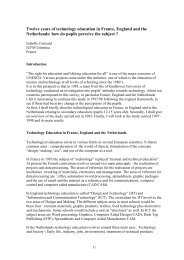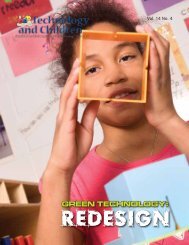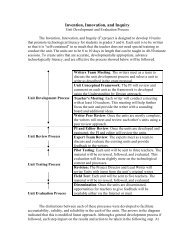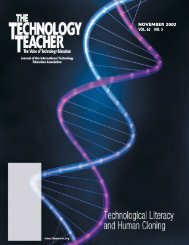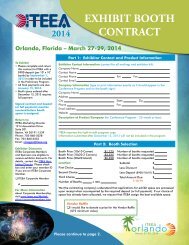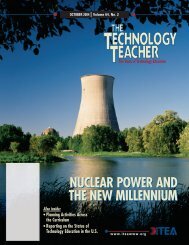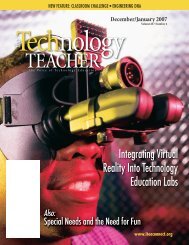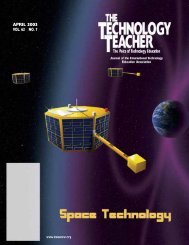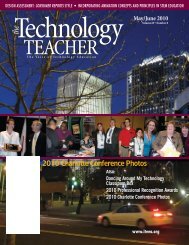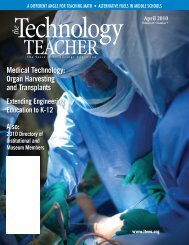May/June 2009 - International Technology and Engineering ...
May/June 2009 - International Technology and Engineering ...
May/June 2009 - International Technology and Engineering ...
Create successful ePaper yourself
Turn your PDF publications into a flip-book with our unique Google optimized e-Paper software.
production, students learn that design is a creative process,<br />
<strong>and</strong> that there is no perfect design, but rather that design<br />
is a compromise of several attributes. Throughout the<br />
preproduction process, students begin to underst<strong>and</strong><br />
that the planning of their television production needs<br />
to be continually checked <strong>and</strong> critiqued, with proactive<br />
refinements to their original plan. An example of refinement<br />
would be time constraints to a production. College<br />
students on their campus CCTV network plan to produce<br />
a quick-meals cooking show for other college students.<br />
Unfortunately, during the actual video production, the<br />
meal takes too long to prepare. In order for the meal to be<br />
completed during the show, students in postproduction<br />
decide to delete the part of the video that lists the<br />
ingredients for the meal. Viewers are directed to a website<br />
where they can print the ingredients instead of taking<br />
precious show time to list <strong>and</strong> explain the ingredients.<br />
This scenario is an appropriate example of how design<br />
can be compromised <strong>and</strong> in this case, the change works<br />
for the best.<br />
This article is designed to introduce the twelve steps<br />
of preproduction that film, television, <strong>and</strong> advertising<br />
producers use. The twelve steps of production is an<br />
authentic design tool in television production technology<br />
that does not hinder student creativity, but rather logically<br />
sequences their ideas into a purposeful <strong>and</strong> working form.<br />
Formative rubrics may be used to assess each of the twelve<br />
steps. All twelve steps can be linked to specific benchmarks<br />
in St<strong>and</strong>ards for Technological Literacy: Content for the<br />
Study of <strong>Technology</strong> (ITEA, 2000/2002/2007). Figure 1<br />
highlights those benchmark connections.<br />
Step Description St<strong>and</strong>ards for Technological Literacy Benchmarks<br />
1 Problem Analysis STL 8-I: Design problems are seldom presented in a clearly defined form.<br />
2 Audience Analysis STL 17-J: The design of a message is influenced by such factors as the<br />
intended audience, medium, purpose, <strong>and</strong> nature of the message.<br />
3 Setting Objectives STL 13-F: Design <strong>and</strong> use instruments to gather data.<br />
4 Basic Research STL 10-J: Technological problems must be researched before they can be<br />
solved.<br />
5 Treatment STL 12-L: Document processes <strong>and</strong> procedures <strong>and</strong> communicate them to<br />
different audiences using appropriate oral <strong>and</strong> written techniques.<br />
6 Content Outline STL 12-L: Document processes <strong>and</strong> procedures <strong>and</strong> communicate them to<br />
different audiences using appropriate oral <strong>and</strong> written techniques.<br />
7 Script STL 12-L: Document processes <strong>and</strong> procedures <strong>and</strong> communicate them to<br />
different audiences using appropriate oral <strong>and</strong> written techniques.<br />
8 Storyboards STL 9-J: <strong>Engineering</strong> design is influenced by personal characteristics,<br />
such as creativity, resourcefulness, <strong>and</strong> the ability to visualize <strong>and</strong> think<br />
abstractly.<br />
9 Camera <strong>and</strong> Lighting Blocking STL 17-K: The use of symbols, measurements, <strong>and</strong> drawings promotes clear<br />
communication by providing a common language to express ideas.<br />
10 Budget Development STL 12-P: Use computers <strong>and</strong> calculators to access, retrieve, organize,<br />
process, maintain, interpret, <strong>and</strong> evaluate data <strong>and</strong> information in order to<br />
communicate.<br />
11 Crew Size STL 11-I: Specify criteria <strong>and</strong> constraints for the design.<br />
12 Production Schedule STL 12-L: Document processes <strong>and</strong> procedures <strong>and</strong> communicate them to<br />
different audiences using appropriate oral <strong>and</strong> written techniques.<br />
Figure 1. Twelve Steps of Preproduction matched to St<strong>and</strong>ards for Technological Literacy Benchmarks.<br />
18 • The <strong>Technology</strong> Teacher • <strong>May</strong>/<strong>June</strong> <strong>2009</strong>



